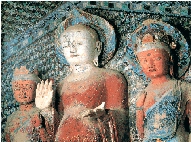 Serving as the westernmost fort of the early Tang Dynasty, Dunhuang was not only a key trading post situated on the "Silk Road" but also the military headquarters for the operations in the Western Regions. Foreign merchants and monks from the West as well as officials and soldiers from central China brought their own cultures to Dunhuang and made the trading center a cultural "melting pot." The economic, military, political and cultural activities which took place at this cross-roads provided the basis for the flourishing of one of China’s earliest Buddhist centers. Serving as the westernmost fort of the early Tang Dynasty, Dunhuang was not only a key trading post situated on the "Silk Road" but also the military headquarters for the operations in the Western Regions. Foreign merchants and monks from the West as well as officials and soldiers from central China brought their own cultures to Dunhuang and made the trading center a cultural "melting pot." The economic, military, political and cultural activities which took place at this cross-roads provided the basis for the flourishing of one of China’s earliest Buddhist centers.
Most Buddhist monks came to China from India and Central Asia by way of the Silk Road. As the westernmost Chinese station on the route, Dunhuang became the ideal place for these foreign monks to learn the Chinese language and culture before entering central China. Foreign monks and their Chinese disciples formed the earliest Buddhist communities at Dunhuang in the late 3rd and early 4th centuries. Many Buddhist sutras were translated at Dunhuang and then distributed into central China. Monk Zhu Fahu, a famous translator of Buddhist texts, organized his translation team at Dunhuang and became known as "The Bodhisattva of Dunhuang." Enormous economic and human resources were used to produce Buddhist sutras and to build places of worship, including thousands of cave temples. By the 5th century, Dunhuang had become an important center of Buddhism on the Silk Road.
|